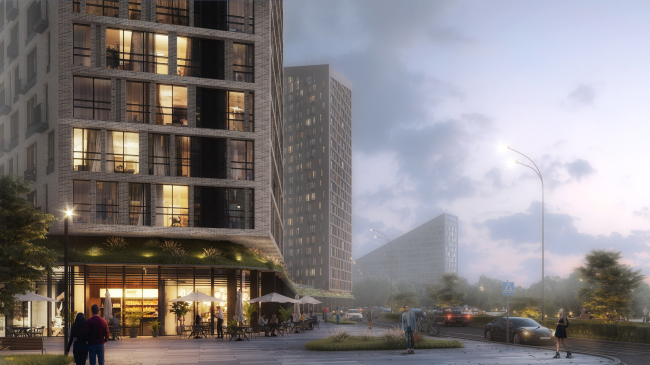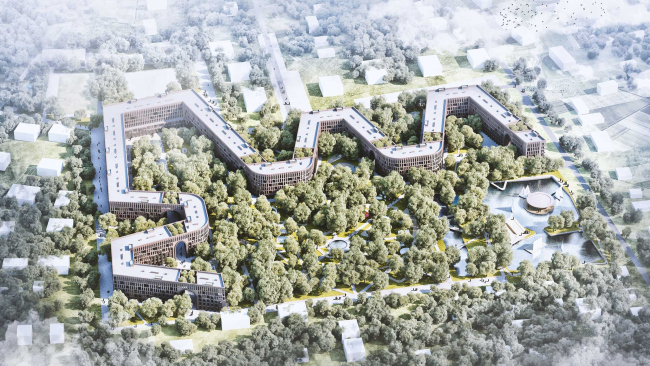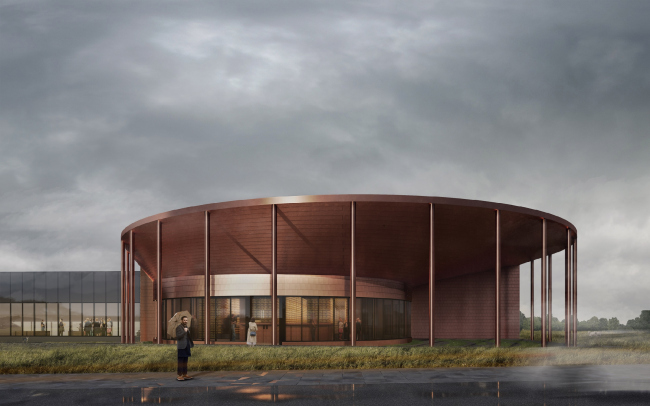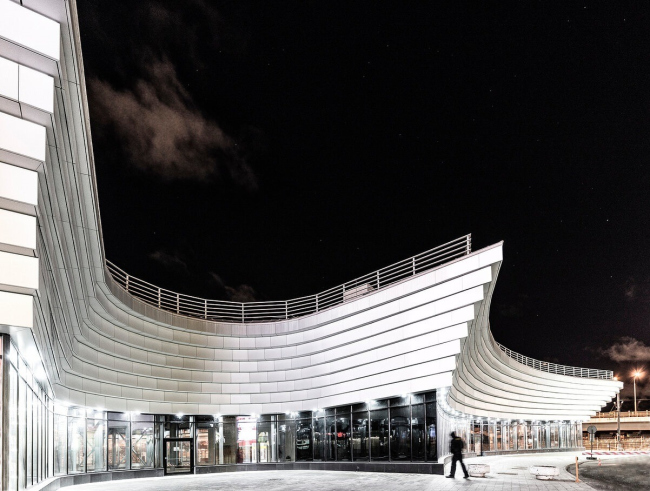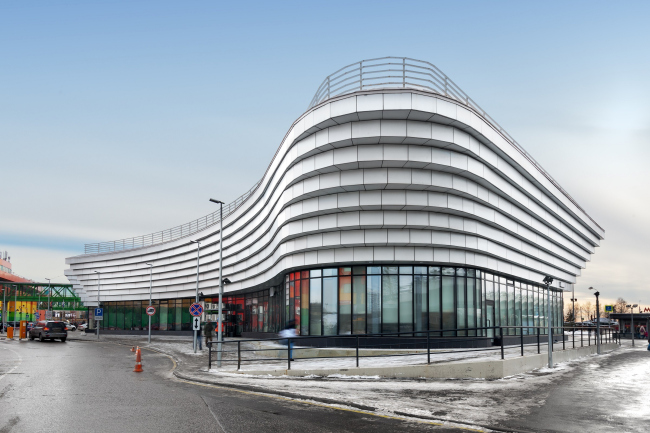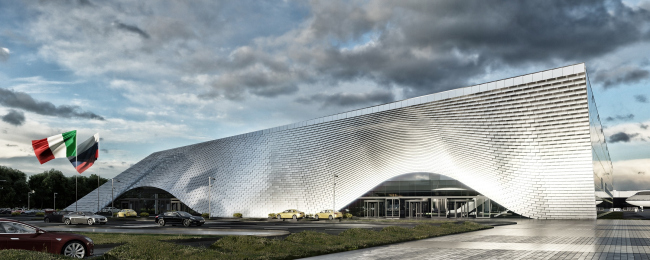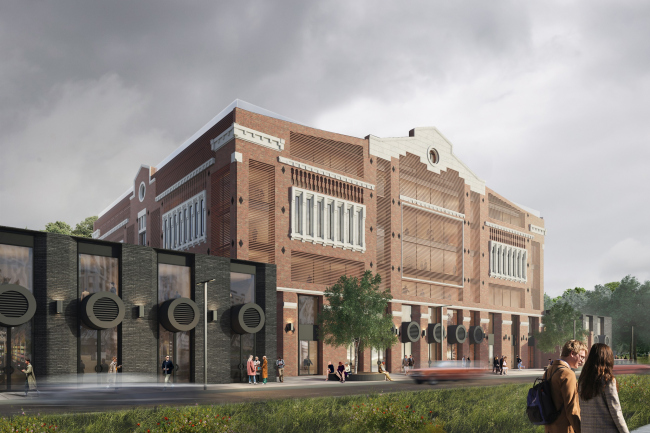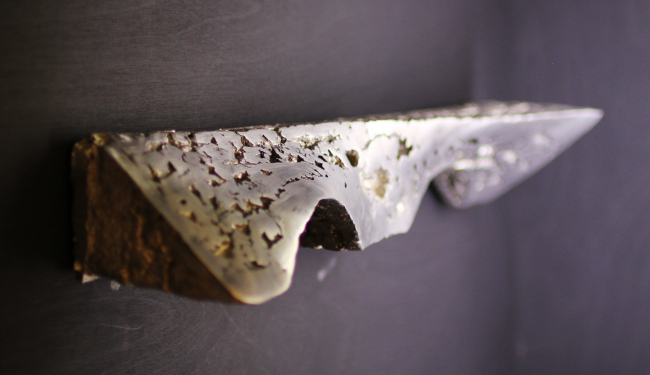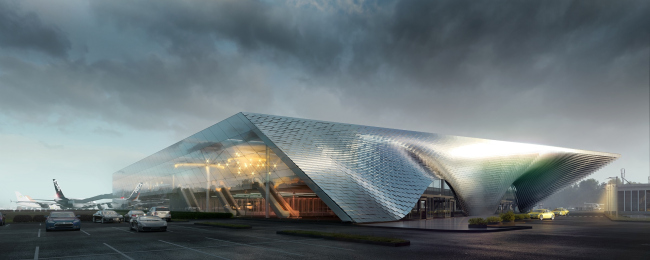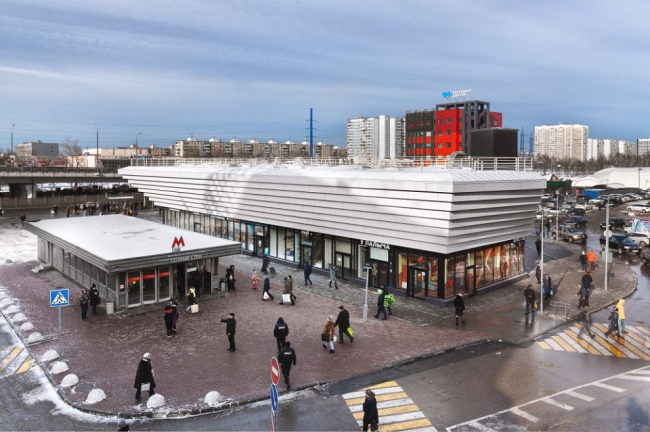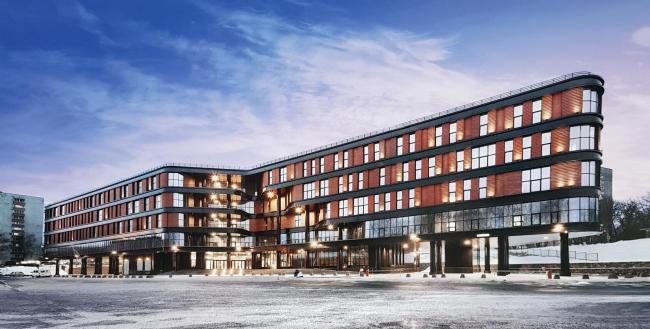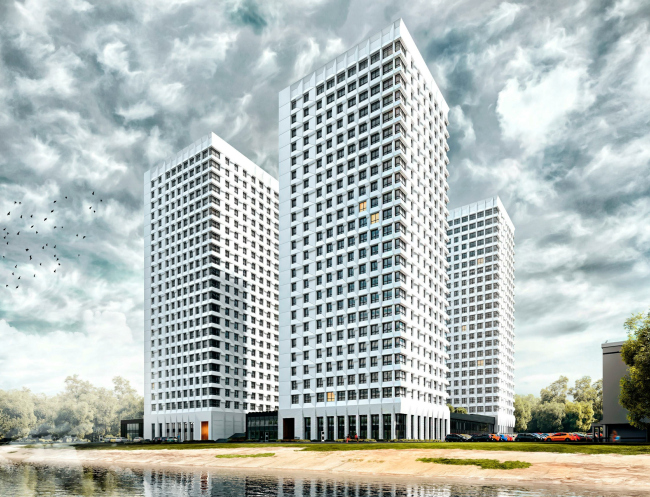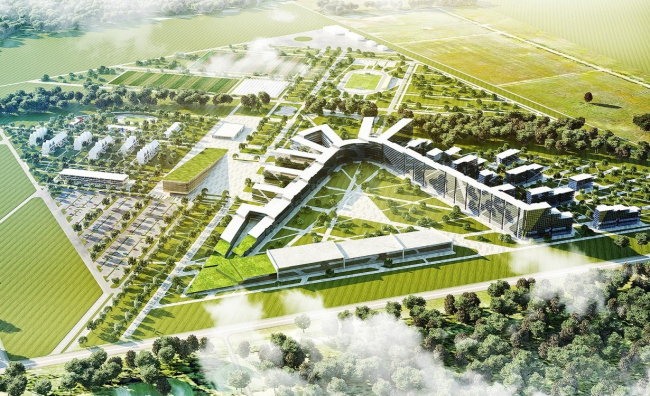|
Published on Archi.ru (https://archi.ru) |
|
| 11.03.2020 | |
|
“Krupny Plan” architects: “It is important that your form should not be accidental; it must have a meaning to it” |
|
|
Julia Tarabarina |
|
| Studio: | |
| KPLN | |
|
A conversation with Sergey Nikeshkin and Andrew Mikhailov, the partners and cofounders of the architectural and engineering company KPLN “Krupny Plan” (“Closeup”) – about the structure of the company, the history of its development, about its principles, its search for form and the notion of “contemporary”. By the industry standards, “Krupny Plan” (“Closeup”) is a relatively young company, which has managed rather quickly – within the 11 years of its existence – to establish itself, landing a few large-scale projects, regularly showing up at various Moscow and all-Russia architectural festivals with projects and implementations; this fall, their project of the shopping mall in Moscow’s Teply Stan district was shortlisted for WAF. The company has more than a hundred employees, and an unusual structure, by today’s standards: it consists of a balanced number of architects, designers, and engineers, which allows it to tackle a wide range of tasks, offering turnkey solutions, taking care of both creative and engineering questions, and illustrating the architects’ ideas with attractive-looking sculptural models. Sergey Nikeshkin and Andrew MikhailovCopyright: © Architectural Bureau KPLNArchi.ru: I have seen the definitions of “Krupny Plan” as a full service company. Could you please elaborate on this? Sergey Nikeshkin: Krupny Plan is a general designer company that takes on the project from beginning to end, meaning – from coming up with the main idea and the overall concept to completing the working documentation and performing the author supervision on the construction site. One of our key advantages is the use of state-of-the-art technologies, which enables us to implement the full cycle of project work with a maximum efficiency. Andrey Mikhailov: We realized very early on that there are not so many companies in Moscow, in which the creative architectural side is backed up by the integrated approach to designing things – such companies are few and far between. On the one hand, there are private architectural offices; on the other hand, there are engineering companies that do not have a “face” of their own. Joining our efforts, we found a successful market niche of our own – and our own clients, who not only wanted to get robust architecture, but also wanted to escape the bother of looking for subcontractors all over the country. For a while, we also worked with subcontractors, but then we realized that outsourcing serious tasks doesn’t pay because it ultimately compromises the quality of the end product. This is how we started to assemble a full service company, which we have been for a few years now. When did you start the operations? On your website, I saw two dates at once, 2009 and 2011... We did not come to the idea of a full service company at once – initially, we planned to work with two individual companies, one engineering and one architectural, and in August 2008 we created the company that was called “Stroyinzhenerproekt” – it is indeed 11 years old. Three years after, however, “Krupny Plan” appeared, and it became the main one. We are the cofounders in both cases. Did you really embark on an independent career immediately after you graduated from the institute? S.N.: Not quite. Initially, we worked for a few years in the company named Format 100 – this is where I met Andrey. I worked there for 6 years, starting from my second year in the institute; my skills as an architect were formed in that company. We still keep up friendly ties with its leader – Elena Alipova – and we recall that time with gratitude. How did you survive the crisis of 2008? A lot of architectural companies closed down at that time, and you just launched your company – how did you stand up to the challenges and grew up to become this big? A.M.: We always diversified the pool of our clients; we never worked with just one or two. In addition to large companies, we also worked with government contracts, and with private clients who are known to be less volatile. We still stick to this strategy today. We did not always grow, by the way; in 2015 we cut our staff from 90 to 70 people, and now we have about 140 employees. “Zurbagan” housing project. Concept for Voronezh, 2018Copyright: © Architectural Bureau KPLNHow hard is it managing an architectural company of 100 employees without compromising the quality? I heard that the optimum number is from 30 to 40, and if you have more people, some of them are bound to screw up. S.N.: Pretty hard. However, speaking of that number, we have about 30 or 40 architects in our team, the others being engineers and designers. A.M.: Yes, when the structure grows too big, you do lose some control, which can affect the degree, to which Sergey and me get involved with each of the projects, our relationship with the clients, and the sheer physical opportunity to be present at every meeting. Today, the number of our employees is reaching the upper limit; we evaluate is as being 150 people or a little bit more. Over that number, the work gets over-bureaucratic, and you lose the opportunity to make decisions quickly. For the time being, we are in the phase of discussing our further growth. A housing project, 2017Copyright: © Architectural Bureau KPLNHow many projects can you take on simultaneously? S.N.: That depends on the size of these projects. I think about 10-15 midsize projects, up to a hundred thousand square meters. It is understood that they are stretched in time – often, they take up not just one, but two or three years. Cheese Factory “Russian Parmesan”Copyright: © Architectural Bureau KPLNYour website says that you work in the BIM software environment. Why did you decide to switch over to it, and how long did it take you? S.N.: It took us about two years. For some time, we debated which software to choose, and then we purchased Revit, which I think was the right choice. In our view, BIM is the best choice for such company as ours, when all the employees work as a single team. However, in this industry things change very quickly, and you always need to refine your competences because the clients’ requirements also grow very quickly, and sometimes they are plain inflated, especially in terms of labor consumption and detailing. To make sure your project stays feasible you have to be on top of things, deciding when you are ready to deliver detailed models, and when detailing is excessive, and you need to negotiate with the client. Mixed-use commercial development in Teply Stan, 2016-2018Copyright: © Architectural Bureau KPLNSpeaking of LEED and BREEAM certificates – have you been able to get them for any of your projects? A.M.: So far, only in the Skolkovo projects, where we took part as an engineering company, doing the design development phase and the working documentation, and after the construction was completed, BREEAM certificates were obtained. As well as for the Skoltech University, where we functioned as the general designer. Do you take on any separate design stages like that or do you turn down such “fragmentary” work? Now, as a rule, we turn such offers down because it upsets our working routine. We can take on a project not from the beginning but, let’s say, from the design development stage, but we do not subscribe to doing engineering work without architecture because we think that one of our key advantages is the fact that all of our departments are interconnected. All employees sit in one and the same room, we have a very friendly environment, and we do not want violate it. We think that this may compromise our reputation and ruin our karma. Besides, there is a large demand for full service projects now. We have been turning down the offers to work with separate stages of outside projects for about two years now. S.N.: Generally speaking, it is obvious that a client will be more comfortable working with a company, to whose office he can come at any moment and discuss all the issues with all the contractors. A.M.: Earlier, when we did not yet work full service, we often had to go to the clients’ offices; now they come to us. As a result, the meetings have become very effective. Mixed-use commercial development in Teply Stan, 2016-2018Copyright: © Architectural Bureau KPLNThe distribution of roles between you as the two leaders, has long since been known: you, Sergey, are the architect, you, Andrey, are the engineer. Could you please elaborate on how you two work together and interact with one another? Each on his own, or are you in constant communication? A.M.: We are two directors, and we have spent our whole life in one office. At one time, we planned to make a partition, yet it never did appear – we understood that even a glass one would be redundant. My responsibility is the administrative and the technical part, while Sergey deals with the creative part. Otherwise, we are in constant communication; we make decisions together, and, most likely, this is what prevents a lot of possible mistakes. Alright, Sergey, then the next question is addressed to you, about the creative side. How do you work with the idea of the project? Do you trust your employees who are in the status of the chief architect of the project with the visual appearance of the new building? In other words, how visionary is your architectural studio? Or is it like a so-called “project institute”? S.N.: Generally, I’ve got nothing against any of my architects coming up with an interesting facade design, and I will readily accept it, but so far this is rarely the case... So far, the main solutions remain my prerogative. Probably, I sometimes want it to be the way that you’ve described but so far; we work with significant contributions from my side. Sometimes, however, we do stage in-company competitions and brainstorming sessions – we announce a specific creative task, then go through all of the proposals, and make a decision by general vote. Then we also award the bonuses. It is a useful experience but it does not always survive into the final project. If I don’t like a proposal, it will not go any further, and I am pretty hard to please. Were there any projects, in which the ideas proposed for the in-company competitions were indeed implemented? The most vivid example is the cycling ground that we once designed. However, I thought that the authors of the idea would care about the further development of the project, which somehow didn’t happen, and it was me again who had to struggle with the client for the ideas of the concept and the quality of architecture, which was far from easy because it was a governmental contract. How often do you take part in competitions? As for open competitions, we haven’t been participating in any of them since our project of Chelyabinsk airport did not win in that open competition. It’s not that we opted out of it on general principle, but looking at this thing that they ultimately built, you lose what desire was left in you to participate ever again. As for closed-door competitions, where you are invited by the client – yes, we do participate in them because working without them would be impossible. Chelyabinsk airport, a competition project, 2016Copyright: © Architectural Bureau KPLNOne of such competitions was won by us fairly recently. This was a competition an office center in Moscow. Currently, we are continuing to improve this project; we showcased it at the “Zodchestvo” festival. Part of the project was reconstructing the refrigerator building that was built in the early XX century – we are preserving it, but we remodel it in the “loft” style, cut new windows, shift some of the inner walls, and add a food court. Behind it, there are three office buildings standing along the driveway. That project is called “The Beetle”. “Beetle” office centerCopyright: © Architectural Bureau KPLNAnd we did not win in another closed-door competition, about which we recently learned – this is a terraced house in the Kaloshin lane. Too bad, I liked that one. The housing project in the Kaloshin Lane, 2019, a projectCopyright: © Architectural Bureau KPLNI have heard a lot about your studio works, could you please share about them? Are they part of the search for a form or are they rather a presentation of an idea that has already taken shape? Me and my wife, we like to live in our country residence, we have a studio there, we enjoy making things with our hands, we make furniture ourselves. And we also enjoy making models from natural materials: wood, metal, ceramics, both baked and unbaked. These works are not involved in the form search. So, yes, finalizing the project and making its presentation. One of the studio works by Sergey Nikeshkin, a model of the competition project of the Chelyabinsk Airport, ArchMoscow 2019Copyright: Photograph: Archi.ruAt various industry events, I saw the model of the already-mentioned Chelyabinsk airport – a metallic building with a curvilinear facade. How did this shape come about, and how do you generally come up with shapes? For me, it is important that my form should not be accidental; it must have a meaning to it. As for the Chelyabinsk airport concept, see here, we’ve got two portals – one is concave, as if it responds to the passenger flow in the departures, and the other is bulging, which is arrivals. Chelyabinsk airport, a competition project, 2016Copyright: © Architectural Bureau KPLNWhich projects can you name as your milestone or signature ones? The project that I like a lot, which got shortlisted for the WAF festival, is the shopping mall in Moscow’s Teply Stan. I believe that its solution turned out to be very balanced and contextual, in lines with the trends of development of modern architecture. Luckily, we had quite a lot of time to design it, and we are also happy with how it was built. Mixed-use commercial development in Teply Stan, 2016-2018Copyright: © Architectural Bureau KPLNMixed-use commercial development in Teply Stan, 2016-2018Copyright: © Architectural Bureau KPLNIn this project, you proceeded from the limitations, in Chelyabinsk, you interpreted the passenger streams – what else do you use to motivate your plastique? There are lots of factors, and it is different every time. Every time you want to make the most of your architectural idea: reflect the history, address the limitations imposed by the land site, and the customer’s requests – and make sure that all of the factors play together in a single orchestra. All tasks are different, and you cannot really unify them. The only steady criterion that you can hold on to is the high quality of architecture. So what does this high quality or architecture mean to you? What properties must it possess? I think that the key word here is appropriateness. For each specific case. Sometimes your project just has to be flashy – if it is a public building, it has to be a stunner. Sometimes, on the other hand, the building must be all but unnoticeable, neatly drawn and tactfully inscribed into its context. Sometimes the building must be invisible, dissolved in the landscape, so as not to obscure something that is more important. Everything depends on a specific task and specific circumstances. To me, the work of art in general, and the work of architecture in particular, must be as contemporary as possible and it must correspond to the world level of cultural and aesthetic development. There is a whole bunch of factors: architecture that’s modern, appropriate, convenient for the client and for the end consumers. After all, we don’t design these buildings for our own selves. Let me take you up on that – what does contemporary mean personally to you? Not postmodernism, in any case. And what does postmodernism mean to you? Postmodernism is a rather broad notion, which covers a lot of areas, including literature and philosophy. Coming up with a quick definition is quite a tall order but I am going to take such liberty. To me, this is first of all, the esthetic eclecticism, the mass culture. But can you get historical allusions as well? For example, if the building reacts to the genius loci? Sadly, I am not guaranteed against that because that’s what the customers often want – some “quoting” and other “literary” effects. There is an arch in this building nearby, so, let’s make an arch in our building as well. Such direct allusions are almost always totally misplaced. Because you can highlight the context with modern means, making the old building sparkle with bright colors from the sheer vicinity with the new one. And your solution does not have to be flashy at all – this can be done in a very tactful manner. You can highlight your modern building and be honest with the context without imitating it, getting an equitable dialogue without any fakes or mimicry. Achieving such dialogue isn’t easy, but that what the architect’s work is all about. Andrey, my next question will be addressed to you – how hard is it working with an architect? A.M.: Over these years, we have developed a methodology [laughs]. I think that Sergey also has to constantly find a balance between commercial success and the creative side. Of course, it is clear that a sophisticated project is consumes more labor than a regular one does. Then we evaluate the complexity and look for a compromise – we search for a solution that will allow us to make the project look sophisticated but implementable from the engineering standpoint. I remember, when we just started, Sergey was more adamant, but now both of us have simmered down; we have learned to go for a reasonable compromise. Sometimes It happens that we would be happy to build something super-expensive but the client simply does not have the money. And we again have to look for a win-win solution. S.N.: Here is an example: the tower of a housing complex. Making the whole thing consisting of standard floors resting on top of one another is boring; if you make various floor plans, this may yield some interesting plastique. But, of course, designing each floor individually, we make it harder for ourselves because we need to tie these floors together and convince the client – but for the sake of architecture you have to work and you have to insist on your solutions. A.M.: As one of our colleagues says, during an operation, the doctor puts his client in narcosis, but nobody does that during construction. Let’s take NPK Krunit as an example – did you have to insist on anything during that project? S.N.: Here the client accepted our work surprisingly quickly, and was happy with us, as opposed to the previous designers whom we didn’t know... But then again, that project did not have that many subtleties about it – maybe the small bearing columns, common for the four floors, and the sunken-in entrance underneath a cantilever, if anything. I don’t like canopies that stick out – I prefer to make my entrance groups as concave spaces. Scientific and industrial complex for the production of electronics and instrumentation. ImplementationCopyright: © Architectural Bureau KPLNAnd can you please recall some cases when you had to struggle or argue with the client? S.N.: It was with the housing complex “31 Quarter”, which is now in construction in Pushkino. It consists of four towers on a podium, and the client wanted us to make this podium a residents-only area, and visually separated from the city. It took us quite a lot of effort to convince him to make this yard open to the general public – and now the podium has to broad staircases on its sides descending to the street and to the river. “Quarter 31” housing complexCopyright: © Architectural Bureau KPLNHow do you plan to develop your company? Do you plan to expand the range of your typology by designing a theater or a park? A.M.: Today, we are interested in educational complexes, we deliberately started to take more of school and kindergarten building projects in order to master that typology. Theaters, of course, are an interesting subject, but it’s a rather private field, and you cannot really get your foot in the door there. Sergey has a dream of designing an airport, and I support him in that. S.N.: Speaking of educational projects, we have a concept of a campus on the Sakhalin Island; it is already six years old. It was put in a state of suspended animation, but now it seems to be developing again. Complex of the Sakhalin University, 2013, a projectCopyright: © Architectural Bureau KPLNWhat makes it interesting is the fact that it combines a park and a rather large educational institution, and they interact with one another. I would say that the landscape inspires us not so much per se, as part of our task, part of the architectural solution. Then it becomes interesting. And, of course, we want to work on those projects that let us explore our full potential – we want to get more effect from our work, more users of our architecture, and a bigger audience. |
|

